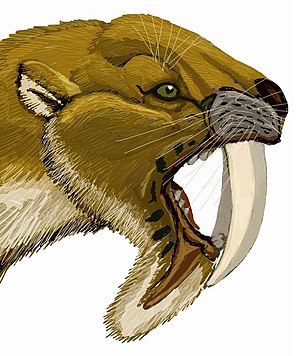Sparassodonta
| Sparassodonta | ||||||||||||
|---|---|---|---|---|---|---|---|---|---|---|---|---|

Head study of Thylacosmilus |
||||||||||||
| Temporal occurrence | ||||||||||||
| Paleocene to Pliocene | ||||||||||||
| 65 to 2 million years | ||||||||||||
| Locations | ||||||||||||
| Systematics | ||||||||||||
|
||||||||||||
| Scientific name | ||||||||||||
| Sparassodonta | ||||||||||||
| Ameghino , 1884 | ||||||||||||
The Sparassodonta or Borhyaenoidea , sometimes referred to in German as " pouch hyenas ", are extinct carnivorous mammals from the tribe of marsupial mammals that were native to South America during large parts of the Cenozoic .
features
The Sparassodonta often showed similarities with the placental predators in their physique , although they were not related to these, but merely developed convergently . This can be seen, for example, in the teeth, where the molars were formed into fangs. The canine teeth were also enlarged in an analogous manner, in later forms such as Thylacosmilus they were so elongated that they were amazingly reminiscent of saber-toothed cats . The strong physique and the relatively short limbs with the clawed toes are adaptations to the predatory way of life. The body size was variable depending on the species: the smaller representatives were comparable to a marten at 80 centimeters , while the larger Sparassodonta reached the size of today's big cats .
Development history
The Sparassodonta lived exclusively in South America . This continent was isolated from other parts of the world during the greater part of the Cenozoic and so a completely independent fauna could develop there - comparable to the situation in Australia . In addition to numerous families of marsupials , there were South American ungulates and a number of secondary animals . The rodents ( guinea pig relatives ) and the primates ( New World monkeys ) did not migrate to South America until a later point in time (probably in the Oligocene ) via the then much smaller Atlantic .
However, there were no carnivorous placenta animals , so that the ecological niche of the carnivores was occupied exclusively by the Sparassodonta, the terror birds (Phorusrhacidae) and the terrestrial crocodiles of the Sebecidae family .
The earliest representatives are known from the lower Paleocene and were still relatively primitive animals, in the Eocene there was then a large amount of radiation . The greatest biodiversity prevailed in the Miocene , from this time more than 20 genera of the Sparassodonta are known. This group of animals then declined, possibly caused by the radiation of terror birds.
Around 2.5 million years ago, the Isthmus of Panama formed the land connection between North and South America and there was a great exchange of fauna . Numerous groups of animals that were previously only found in North America immigrated to South America. At this point in time only Thylacosmilus can be detected from the Sparassodonta . This species was soon supplanted by the superior predators such as dogs and cats and the Sparassodonta were extinct.
Systematics
The family relationships of the Sparassodonta are not exactly clarified. In the past, because of their carnivorous way of life, they were placed in a close relationship with other carnivorous marsupial mammals such as the thylacine or the predatory mammals - but the similarities are only superficial. Later, they were in the superiority of the ameridelphia found today they are considered core group representatives of the marsupials (Marsupialia) and are provided along with this in the parent taxon Metatheria.
A total of six families of the Sparassodonta are known:
- Mayulestidae , the most primitive representatives
- Hathliacynidae
- Borhyaenidae , including the bear-like Borhyaena
- Proborhyaenidae , including Proborhyaena, the largest representative of the Sparassodonta
- Prothylacinidae
- Thylacosmilidae , a group of saber-toothed cat-like canines, best known in Thylacosmilus
literature
- TS Kemp: The Origin & Evolution of Mammals. Oxford University Press, Oxford 2005, ISBN 0-19-850761-5